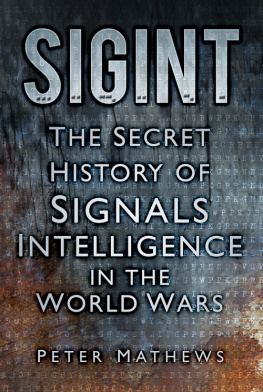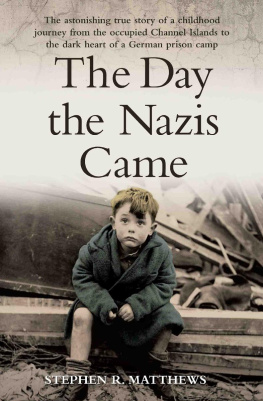Matthews - SIGINT : the Secret History of Signals Intelligence in the World Wars
Here you can read online Matthews - SIGINT : the Secret History of Signals Intelligence in the World Wars full text of the book (entire story) in english for free. Download pdf and epub, get meaning, cover and reviews about this ebook. City: Stroud, year: 2013, publisher: The History Press, genre: History. Description of the work, (preface) as well as reviews are available. Best literature library LitArk.com created for fans of good reading and offers a wide selection of genres:
Romance novel
Science fiction
Adventure
Detective
Science
History
Home and family
Prose
Art
Politics
Computer
Non-fiction
Religion
Business
Children
Humor
Choose a favorite category and find really read worthwhile books. Enjoy immersion in the world of imagination, feel the emotions of the characters or learn something new for yourself, make an fascinating discovery.
SIGINT : the Secret History of Signals Intelligence in the World Wars: summary, description and annotation
We offer to read an annotation, description, summary or preface (depends on what the author of the book "SIGINT : the Secret History of Signals Intelligence in the World Wars" wrote himself). If you haven't found the necessary information about the book — write in the comments, we will try to find it.
SIGINT : the Secret History of Signals Intelligence in the World Wars — read online for free the complete book (whole text) full work
Below is the text of the book, divided by pages. System saving the place of the last page read, allows you to conveniently read the book "SIGINT : the Secret History of Signals Intelligence in the World Wars" online for free, without having to search again every time where you left off. Put a bookmark, and you can go to the page where you finished reading at any time.
Font size:
Interval:
Bookmark:

To my grandchildren, Hannah, Alex, Piers,
Elliot, Natasha and one yet unborn.
I am pleased to acknowledge the advice and help of all those mentioned below and thank them for helping iron out some of the wrinkles in the book:
James Gates, who helped with validating some coding exercises and assisting with the mysteries of computing when several chapters of my book disappeared from my computers memory.
Joseph Mankowitz, who encouraged me with snippets of military history and participated in an exciting visit to Chicksands Priory which was a Listening Station for the Royal Air Force during the war. It is still in operation as a British Army Intelligence Corps unit.
Paul Croxson, who was my rock in writing the book and put me right on much in the intelligence world with kind comment and guidance. He served in the Intelligence Corps in GCHQ and Germany as a traffic analyst. He is now a voluntary archivist in the Intelligence Corps Museum at Chicksands Priory and researching the history of SIGINT.
Marylyn Blackwell provided information about the Tirpitz from the archives of Lieutenant Norman Gryspeert RN.
The British Library staff and, particularly, Cathy Collins who guided me towards the accounts of the wartime actions in the four-page skimpy newspapers of the time in the new National Press Archive.
Clive Matthews, who instructed me in the use of social media and helped me carry out an interview on the CNN Network in the USA about this book.
The Public R ecords Office (National Archives, Kew) where many obliging staff guided me towards the captured logs of U-boats and British warships fighting the war at sea in both wars. The log of my grandfathers ship HMS Venus in operation from Queenstown in Southern Ireland was of particular interest to me.
Various members of the Imperial War Museum in London, but in particular Nick Vanderpeet and his staff at its Formal Learning Department. The exhibits in the Secret War section of agents operating gave the feel of the equipment they used.
The German Bundesarchiv in Koblenz have guided me through the early history of the German Federal Intelligence Agency ( Bundesnachrichtendienst or BND for short) where Dr Hechelhammer has helped with information about the spymaster General Gehlen.
Randy Rezabek in Los Angeles, who maintains an encylopedic archive on the subject of TICOM (Target Intelligence Committee) and provided documentation on German intelligence matters, some of which are quoted in this book.
Werner Sunkel, a volunteer curator at the Wehrtechnik Museum in Nurnberg, whose father was Oberwachtmeister (Sergeant Major) at Lauf and left photos, some of which are reproduced here.
Dr Steven Weiss, with whom I had discussions about Operation Anvil, in which he was involved as a soldier, and his experiences with the French Resistance, and he kindly shared his photographs with me for this book.
Members of the Tunbridge Wells Library who surprised me by seeking out many books for my research.
The German Wehrmacht veterans of the Abwehr (German military intelligence), most of whose names I have forgotten, whom I knew and talked with in Berlin as the Second World War ended and the Cold War began. Their wartime experiences, often recounted at great length during the long days and dark nights of the Berlin Airlift, are used in this book.
Wilhelm H. Flicke (now deceased) who I got to know well was one of those mentioned above who gave me his papers that have formed a part of this book. I have had his badly typed memoirs deposited in the rare books section of the research library of the Imperial War Museum.
Last and most appreciated is my wife Carole, who supported me uncomplainingly during the hours that I spent at the computer and even read and corrected the manuscript of this book.
The SIGINT Battlefield
The Value of SIGINT
Cable Wars
Wireless Telegraphy Pioneers
The History of Codes
Codes and Codewords
Interceptions and Encryption
Decryption
Frequency Analysis
Intelligence in Signals
Politicians and Intelligence
German Intelligence
Germanys Allies
Allied Intelligence
The Reasons for War
The Battle of Tannenberg
SIGINT in Galicia
The Miracle of the Marne
The Race to the Sea
In the Trenches
The Direction Finding Service
The French Goniometric Service
Romania and Russia
Room 40 at the Admiralty
Codes in the War at Sea
Directionals at Sea
U-boats and Convoys
Surface Raiders
The North Sea
Jutland
Zeppelins and Gothas
Air Battles in France
America Drifts into War
The Lusitania
Zimmermann and America
1918 and the End Game
The Yanks are Coming
Brest-Litovsk
Compigne and the Armistice
Minor Wars
Polish Con-Men
TICOM Analysis
The Players
German Intelligence
Cipher Machines
Non-Belligerents
Czechoslovakia and Poland
The Phoney War
Norway
The Battle for France and Dunkirk
Britains Air War
The Battle of the Atlantic
Raiding Europe
Germanys Surface Fleet
The Balkans
The Middle East
The Desert Campaign
The Afrika Korps
The Torch Landings
Russia
Russian Battlefield Intelligence
Japan
Sicily and Italy
Counter Intelligence
Scandinavian Resistance
France
Belgium
Holland and the North Pole
D-Day
The Battle for France and the Bulge
Middle Europe Poland and Czechoslovakia
The Bomb Plot
The Wars End
Beginning Again
As war ended in 1945, some of the German Wehrmachts most experienced signals intelligence operators began working for Anglo-American intelligence against the Russians. As a young soldier I mixed with them, perfecting my German as I talked with them at length and listened to their experiences. I was tolerated because I brought cigarettes, which were in very short supply in Germany at that time. They believed themselves to be the elite in signals intelligence at that time and, from their tales related to me in 1947, so did I. The triumphs and few tragedies they related at that time sounded good, but they knew little of the reverses that the Wehrmacht suffered in the signals intelligence war. So we all believed their tales of outwitting the enemy. It was not until almost thirty years later that the story of Bletchley Park began to emerge and I can imagine the astonishment they felt as the secrets began to be revealed. Most of the German signals intelligence warriors that I had met with and listened to with rapped attention in 1947 would have been dead by the time that we all knew of the story of Ultra intelligence. They have left me impressed with their achievements, even though their work had been eclipsed by Bletchley Park. They even gave me some of their private papers (bought from them for a few cigarettes which they probably used in trading on the black market).
I have been re-reading their accounts of the 1940s and have tried to set them into the considerable body of literature that has been published about British cryptography and smiled at the naivety of those German cryptographers. I decided to write this book to try and compare the abilities and shortcomings of the signals intelligence agencies of the belligerents in the two great wars of the twentieth century.
The book traces the emergence and maturity of electronic signals interception and decryption in the first half of the twentieth century, and its effect on the warring nations of the world. The place of signals intelligence, or SIGINT, in military history is not just about Bletchley Park and Enigma, but the way that the intercept services of armies, navies and air forces competed to gain advantage in battle. Intercept services of Germanys Abwehr, Frances Deuxime Bureau and the British Admiralty Room 40 all vied with each other in their different fields from the inception of signals intelligence before the First World War. The first steps in electronic warfare had been laid and preparations were made during the inter-war years for the signals intelligence battle in the Second World War. This is its tumultuous story.
Next pageFont size:
Interval:
Bookmark:
Similar books «SIGINT : the Secret History of Signals Intelligence in the World Wars»
Look at similar books to SIGINT : the Secret History of Signals Intelligence in the World Wars. We have selected literature similar in name and meaning in the hope of providing readers with more options to find new, interesting, not yet read works.
Discussion, reviews of the book SIGINT : the Secret History of Signals Intelligence in the World Wars and just readers' own opinions. Leave your comments, write what you think about the work, its meaning or the main characters. Specify what exactly you liked and what you didn't like, and why you think so.















